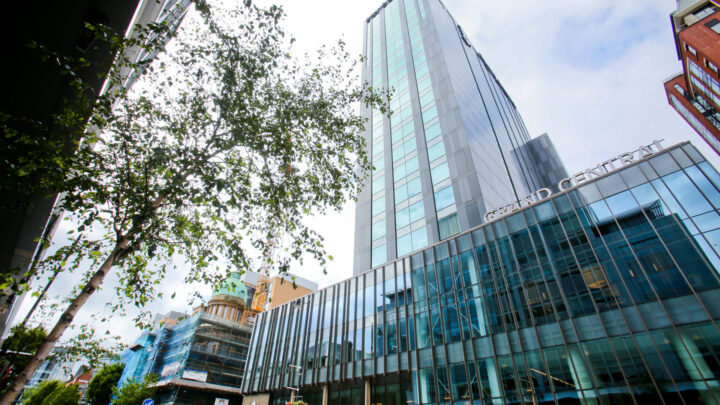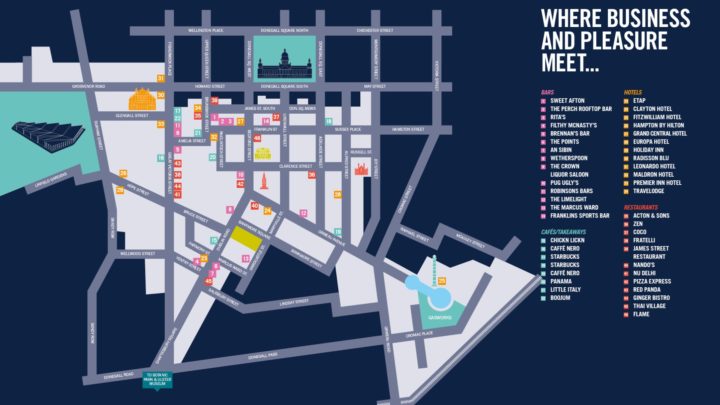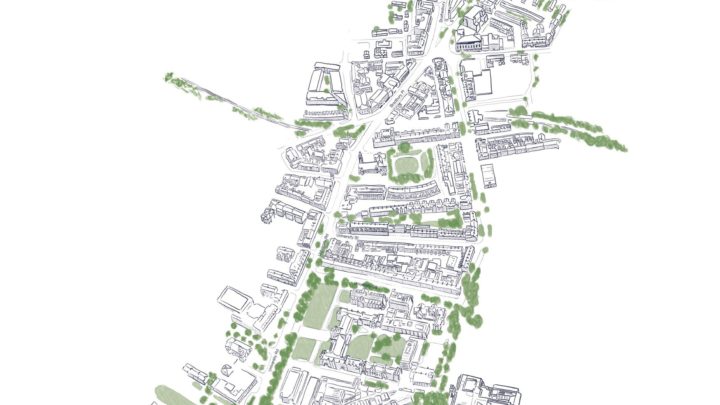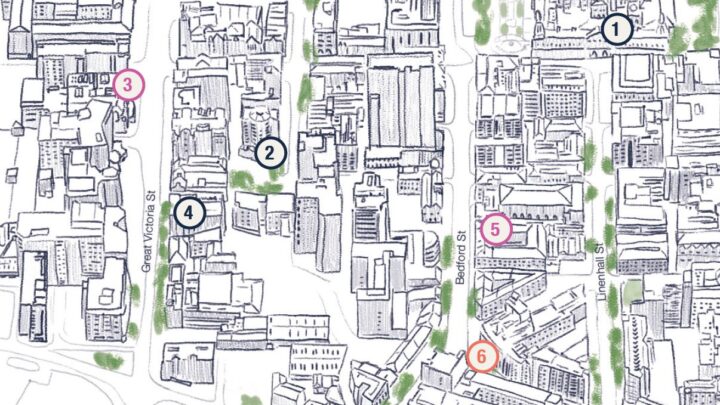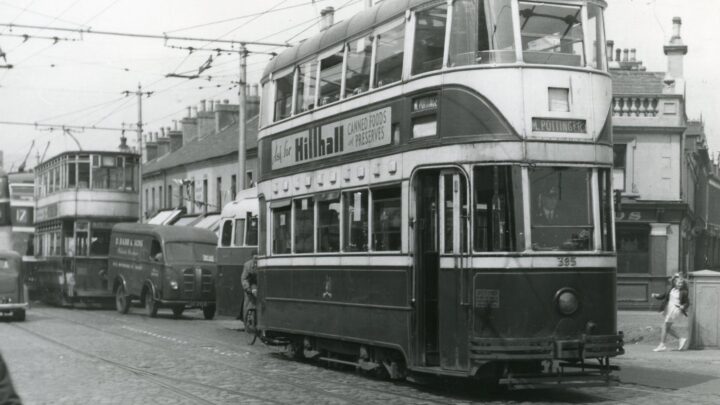History of the Linen Quarter
The 17th & 18th Centuries
The area occupied by the Linen Quarter today was originally marshy land that formed part of the estuary where the river Blackstaff flowed into the Lagan. The only habitable ground to the south of the 17th century city were the sandbanks on the western high-water mark of this estuary. This became the principal thoroughfare leading south towards Lisburn, and ultimately, Dublin. The old route can still be recognised as today’s Sandy Row.
The only noticeable development in this area was the paper mill that was established along the river Blackstaff by the Joy family . It occupied the ground around the eastern end of today’s Ormeau Avenue and is remembered through the name of Joy Street to this day.
This situation persisted well into the 18th century, when the former castle gardens of Belfast Castle (burned down in 1708) were developed into a new city quarter with Donegall Place and the White Linen Hall (completed in 1788) at its heart. Consequently, Linen hall street was opened behind the White Linen Hall and soon other streets followed, including Dublin Road in 1809 and Great Victoria Street in 1823.
The Transport Revolution
The opening of the Gasworks by the Lagan river, and the railway station at Great Victoria Street, helped fuel the remarkable growth of this part of Belfast. After plans for the Ulster Railway were announced in 1835, Belfast joined the railway revolution in 1839, when the first section from Belfast to Lisburn was opened for passenger traffic. A fitting railway terminus was built on Great Victoria Street and opened in 1848.
The completion of the Dublin and Belfast Junction Railway made Victoria Street, soon known as ‘Great Victoria Street’, the terminus for one of the most important main lines in Ireland. Over the following decades commuter traffic to from neighbouring towns to Belfast grew rapidly. During the 1960s much of the original terminal at Great Victoria Street was demolished to make way for the development of the Europa Hotel and a bus station.
Hospitality & Entertainment
In the first half of the 19th century, inns offering food and lodging sprang up around the newly opened Great Victoria Street terminus. In 1839 The Ulster Railway Tavern opens in Great Victoria Street (refurbished and renamed Crown Liquor Saloon in 1888), while virtually next door, the Dublin and Armagh Hotel opened (now Robinsons). Across Amelia Street from the Crown was the Downshire Arms Hotel and its site is now occupied by Brennans’ Bar.
The Linen Quarter has also been at the heart of Belfast’s entertainment scene since the 19th century. Completed in 1862 as a grand ballroom, the Ulster Hall became one of the largest music halls in the British Isles. It has hosted a range of world famous artists including include Count John McCormack, Paul Robeson, Caruso, Edward Elgar, Sir Thomas Beecham, Sidney Bechet, the Rolling Stones, U2 and Rory Gallagher.
The 19th century was also a boom period for the circus in Belfast, and many were staged in the Linen Quarter. The Grand Opera House was opened in 1895 as the ‘Cirque and Grand Opera House’ and presented several circuses. Since its opening it has hosted many of the world’s greatest entertainers, including Laurel and Hardy, Sir Henry Irving and Ellen Terry, Gracie Fields, Sarah Bernhardt and Luciano Pavarotti, who made his UK debut there.
The BBC has been an integral part of the Linen Quarter since it made its first Northern Irish broadcast on September 15th, 1924 from its first studio located in Linenhall Street. BBC’s new Northern Ireland headquarters in Ormeau Avenue (Broadcasting House) were completed in 1939.
Innovation Hub
Innovation was crucial to the industrial and manufacturing boom that swept through the city from the late Victorian to Edwardian era and to the development of the Linen Quarter. Initially, it was Belfast’s cotton industry that drew thousands in from the surrounding countryside. Innovative mechanized methods of production were adopted that allowed the dramatic rise of Ireland’s mechanised linen industry. After the first mechanised linen industry was set up by the Mulholland family in their Linen mills in York Street in the 1820s), the area gradually became the centre of the linen trade, with offices and warehouses for major Linen companies built south of the White Linen Hall congregating around Bedford Street. Several of these companies rose to global prominence by continuing this process of industrial pioneering. The economic importance of the linen trade for the city is acknowledged in the nickname of “Linenopolis” that was assigned to Belfast during the industrial era.
Andrew Mulholland, who donated the Ulster Hall’s magnificent organ, oversaw a company that built the world’s largest and one of its most advanced linen mills. Daniel Jaffe, one of the pioneers of linen in Belfast, had his Irish base at what is now the Ten Square Hotel, while William Ewart and Sons, one of the world’s greatest linen manufacturers, had a large establishment in Bedford Street.
The 20th Century
Many of the linen warehouses dating back to the 19th century still survive in the Linen Quarter to this day, such as Ewart’s buildings, Bryson House, Yorkshire House, Armagh House, and Tyrone House, which once housed the Franklin Steam Laundry. Most of these have now been converted into new office premises or apartments.
With some downturns and recoveries along the way the linen industry survived until the Second World War. But after that, rising costs, new synthetic materials and foreign competition saw it collapse. With the outbreak of civil unrest during the period from 1970 onwards, better known as ‘the Troubles’, the area experienced further decline and became semi-derelict for decades.
After the signing of the 1998 Good Friday Agreement, renewed investment kick-started an economic revival in Northern Ireland in general, and in the Linen Quarter in particular.
The Linen Quarter Today
Since 2015, the Linen Quarter has attracted a large amount of investment in the form of various regeneration projects. In order to facilitate ongoing and future investment the Linen Quarter BID was formed in 2018 following a democratic vote by local business. Its role is to promote the district, co-ordinate regeneration activity, and improve community safety and general upkeep of the district.
Transport continues to be a crucial theme in the further development of the district. The Belfast Transport Hub will reaffirm the Linen Quarter as the main gateway to Belfast once opened, and is expected to facilitate 20m passenger movements each year. A new North-South Glider route will run through the district and thereby promote the use of local public transport, while the anticipated development of a pedestrian/cycling bridge over the river Lagan and new cycle greenways will boost the use of other forms of sustainable transport such as walking and cycling.
Today, the Linen Quarter is leading the way in innovation, particularly by facilitating the adjustment of Belfast’s economy to the 21st century. The district has seen the transformation of its many linen warehouses into swanky new offices that have attracted a number of international technology, consultancy and design firms to the area, including Kainos, BBC, Deloitte, EY, ARUP, and Liberty IT. This influx of international knowhow is supplemented by the successful establishment of various indigenous companies in the district. Housed in the historic Ormeau Baths, the Tech Hub was opened in 2017 to help drive Belfast’s nascent high tech industry by providing a co-operative networking centre for tech start-up companies.
A dramatic boom in the hotel sector with £150m of local investment since 2018 confirms the Linen Quarter as the most important hotel district within Northern Ireland. The opening of the £53 million Grand Central Hotel by the Hastings Hotel Group, comfortably the biggest hotel ever built in the city, is accompanied the recent establishment of other hotels including the Maldron, Hampton by Hilton and the Etap Hotel. Major investment in the entertainment sector, such as the ongoing Grand Opera House restoration, means that the district boosts a range of historic venues with state of the art facilities.
The Linen Quarter is rapidly becoming one of the most vibrant “must visit” areas of the city, and thoroughly deserves its contemporary reputation as “the new home for hospitality”.
Learn more about the history of Belfast’s public transport network here.
Additional info on the Linen Quarter can be found on the relevant Wikipedia page: https://en.wikipedia.org/wiki/Linen_Quarter,_Belfast
Timeline
1750s – The first post chaise to operate between Belfast and Dublin begins service. It leaves Dublin every Monday and Belfast every Thursday, taking three days in winter and two in summer to complete the journey. The route passes through the old Dublin Road and Sandy Row.
1779 – The first cotton mill in Ireland opens just outside Belfast.
1809 – The new Dublin Road is opened. Great Victoria Street opens 14 years later.
1820s – The Belfast Gasworks is established by the Lagan river. It will help fuel the remarkable growth that puts Belfast at the centre of the Victorian industrial revolution.
1830 – The Mulholland family rebuild their cotton mill in York Street as a linen mill. It heralds the dawn of Belfast’s world leading mechanised linen industry. Other entrepreneurs take note of their increasing success.
1835 – Plans for the Ulster Railway are announced.
1839 – A section of railway from Belfast to Lisburn opens for passenger traffic. The Ulster Railway Tavern opens in Great Victoria Street around this time. Under another name it is now Belfast’s most famous pub.
1844 – One of the most beautiful churches in Belfast, St Malachys, is opened in Alfred Street.
1848 – The Belfast Railway Terminus is opened in Great Victoria Street.
1850s – The linen boom is well underway. By 1856 the York Street Mill is claimed to be the biggest mill of its kind in the world. The major linen companies are establishing offices and warehouses in the area now known as the Linen Quarter.
1862 – The Ulster Hall is opened as a grand ballroom in Bedford Street. It is one of the largest music halls in the British Isles. Its magnificent organ is donated by the Mulholland family.
1869 – Charles Dickens reads ‘A Christmas Carol’, ‘The Pickwick Papers’ and ‘David Copperfield’ at two separate readings at the Ulster Hall.
1885 -Michael Flanagan and son renovate the Ulster Railway Tavern with the help of skilled Italian craftsmen. They name it the Crown Liquor Saloon.
1887 – The Ormeau Baths opens. A public baths, it serves a population for whom plumbing is a distant dream. Today this beautiful building hosts the Tech Hub, which is helping drive Belfast’s nascent high tech industry.
1888 – John Dunlop invents the pneumatic tyre in his workshop at 38-42 May Street, on the fringes of the Linen Quarter. Cycling becomes more enjoyable and more popular. His invention will have major benefits for motor travel too.
1888 – Belfast, now the world’s greatest linen producer, is awarded city status by Queen Victoria. Its pre-eminence in linen manufacture is one reason for the award.
1895 – The Grand Opera House, designed by Frank Matcham, opens in Great Victoria Street. Like the Ulster Hall it will host many of the great names of entertainment, including Laurel and Hardy and Luciano Pavarotti, who makes his UK debut here.
1924 – The BBC opens its first studio in Linenhall Street. The great actor manager Tyrone Guthrie makes the first broadcast here on September 15th.
1926 – Belfast Corporation (Belfast City Council) introduces buses, initially to supplement the tram service, but gradually replacing them.
1954 – The last tram service in Belfast is closed.
1968 – Belfast’s famous trolleybuses come to an end.
1971 – Led Zeppelin debuts one of the most famous songs in rock history, ‘Stairway to Heaven’, at the Ulster Hall.
1973 – Translink takes over the running of public transport in Belfast.
1995 – The second Great Victoria Street Station opens, just yards from the site of its predecessor.
2017 – Local organisations agree to form a business improvement district following a democratic vote. Linen Quarter BID starts work the following year.
2018 – The £50 million Grand Central Hotel, Belfast’s biggest ever hotel, is opened on Bedford Street by Hastings Hotels.
2024 – The £225 million Belfast Transport Hub is scheduled to open. It will have eight platforms, twice as many as Great Victoria Street. The Enterprise Belfast to Dublin service will terminate here.
![Belfast in 1978 [credit: Reddit - Rimbaud82]](https://linenquarter.org/app/uploads/2025/10/Belfast-1978-720x405-1.jpg)
![Joy's Paper Mill [credit: National Museums of Northern Ireland]](https://linenquarter.org/app/uploads/2025/10/Joys-Paper-Mill.jpg)
![White Linen Hall 1888 [credit: John Anderson]](https://linenquarter.org/app/uploads/2020/07/White-Linen-Hall-1888-640x405.jpg)
![Grand Opera House, 1903 [credit: National Library of Ireland]](https://linenquarter.org/app/uploads/2020/07/Grand-Opera-House-1903-615x405.jpg)
![Broadcasting House [credit: John McDonald]](https://linenquarter.org/app/uploads/2020/07/Broadcasting-House-720x405.jpg)
![Belfast in 1923 with Linen Quarter in bottom half of photograph [credit: Historic England]](https://linenquarter.org/app/uploads/2025/10/Belfast-in-1923-with-Linen-Quarter-in-bottom-half-of-photograph-400x400-1.jpg)
![Bedford Street 1902 [credit: National Library of Ireland]](https://linenquarter.org/app/uploads/2025/10/Bedford-Street-1902-400x328-1.jpg)
![The Ewart building following restoration as part of the Bedford Square 2 scheme [credit: The Ewart Belfast]](https://linenquarter.org/app/uploads/2025/10/Ewart_MRP_JLPhoto-65-1024x683-1-720x405.jpg)
